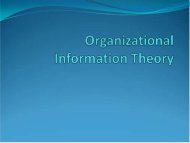Cognitive Dissonance Theory
Cognitive Dissonance Theory
Cognitive Dissonance Theory
- No tags were found...
You also want an ePaper? Increase the reach of your titles
YUMPU automatically turns print PDFs into web optimized ePapers that Google loves.
<strong>Cognitive</strong> <strong>Dissonance</strong> <strong>Theory</strong>And the general topic ofattitude change1
What is <strong>Cognitive</strong> <strong>Dissonance</strong>?• <strong>Cognitive</strong> <strong>Dissonance</strong> happen whenpeople “find themselves doing thingsthat don’t fit what they know, or havingopinions that don’t fit with otheropinions that they hold.”– Leon Festinger, 19572
<strong>Cognitive</strong> <strong>Dissonance</strong>• We like relationships to balance.• Unbalanced relationships make usuncomfortable (dissonance).• We rebalance relationships by changingattitudes.• Actually, we don't always.• We can also compartmentalize, go into denial, etc.• Behavioral changes3
<strong>Cognitive</strong> <strong>Dissonance</strong>• Consonant relationship – the twoelements of interest are in equilibriumwith one another.• Dissonant, they’re not.• Irrelevant – there really isn’t arelationship between the two elements• Can you come up with examples?4
<strong>Cognitive</strong> <strong>Dissonance</strong> – Assumptions1. Humans desire consistency in their beliefs,attitudes, and behaviors.2. <strong>Dissonance</strong> is created by psychologicalinconsistencies (not necessarily logicalinconsistencies),3. <strong>Dissonance</strong> is an aversive state that drivespeople to action with measurable effects.1. I.e. a drive, that leads to arousal.4. <strong>Dissonance</strong> motivates efforts to achieveconsistency and reduce dissonance.5
The Root Concepts• Belief: the idea that something is true• It doesn’t have to be “objectively true”.• Attitude: that the idea thought to betrue is a good or bad thing.• The + or – evaluation is called valence.• We will be seeing more about Attitude.• Opinion: expressing a belief or attitude• Behavior: actions manifested in theworld.6
Basic Balance <strong>Theory</strong> (Heider)Topic XTopic X+++ –Person A+Person BPerson A?Person BTopic XPerson A+ +–Person BThe enemy of myenemy is my friend.7
Measuring <strong>Cognitive</strong> <strong>Dissonance</strong>• Quantitative… How Much?• Magnitude of <strong>Dissonance</strong>• Importance (of the issue)• <strong>Dissonance</strong> Ratio (of consonantcognitions to dissonant cognitions)• Rationale – the reasoning (if it can becalled that) used to explain theinconsistency.8
Reducing <strong>Dissonance</strong>• Two ways:• Behavioral• Compartmentalization (“divide your brain”)• Take action (quit job, break up, etc.)• Communicative and non-communicative• Attitudinal• Reduce importance or number of dissonant beliefs• Add to or boost importance of consonant beliefs• Eliminate the dissonance in some way– (Projection, denial, avoidance, wishful thinking)9
The CDT ModelInconsistentattitudes,thoughts andbehaviorsOnset of<strong>Dissonance</strong>UnpleasantarousalBehaviorsthat reduceor removedissonance10
Coping Strategies• Selective exposure – looking elsewhere forinformation that is more agreeable• Selective attention – choosing what to payattention to.• Selective interpretation – when information isambiguous, putting a spin on it.• Selective retention – deciding what to recall.We tend to forget inconsistent informationmore quickly.• Can you come up with examples?11
Minimal Justification• <strong>Cognitive</strong> <strong>Dissonance</strong> studies have come up with theoccasional counterintuitive finding….• The boring task experiment (Festinger and Carlsmith 1959).• Minimal justification: doing something you don’tbelieve in for a minimal reward sets up moredissonance than doing that same thing for a largerreward.• Minimal justification has been criticized as possiblycaused by other factors than CD. Do you thing thisworks the way it’s described?12
Cog. Diss. And Behavior• <strong>Cognitive</strong> <strong>Dissonance</strong> figures intovarious forms of decision-makingbehavior:• Buyer’s remorse• Bettor’s remorse• Quitting smoking• “Mrs. Keech”• This is a kind of “groupthink.”• CD is often a “post-decision” result.13
Cog. Diss. And Behavior• <strong>Cognitive</strong> <strong>Dissonance</strong> also figures intonon-decision-making behavior.• E.g. coping strategies after job loss(Buzzanell and Turner 2003):• Act as if everything is normal.• Push positive themes to the foregroundand negative themes to the background.• Reassure members as to the continuedlegitimacy of their roles.14
15ATTITUDE
What is Attitude?• Attitude: “Attitude is a psychologicaltendency that is expressed by evaluating aparticular entity with some degree of favor ordisfavor”– Eagly & Chaiken, 1993• The “psychological tendency” is an internal statethat can be overt or covert, and involve affect,behavior or cognition.• The evaluation is usually termed the valence.16
What is Attitude?• Many theories of attitude add anadditional dimension: potency, howstrongly held an attitude is.• Thus, you can hold the attitude that youhave a mild dislike of broccoli verystrongly.• Attitude is a nominal, or hypothetical,concept… one we can’t actuallyobserve.17
Attitude is Central• Everyone has attitudes about literallyeverything.• You can measure it in surveys, as in…“On a scale of 1 to 7, where 1 meansdislike extremely and 7 means likeextremely, please rate the following…”• This is called a Likert scale, and it canbe used to measure liking, agreement,desirability, importance, etc.18
Attitude is Central• Attitude is considered motivational,and so affects behavior.• But the pathway isn’t as clearcut as itseems.19
Basic “Path” ModelBeliefs Attitudes BehaviorAs it turns out, this isn’t quite it….20
Better “Path” ModelBeliefsAttitudesBehavioralIntentionBehavior21
The Root Concepts: Dr. Krull's Version• Centrality of beliefs and attitudes: how many otherbeliefs and attitudes are connected to a particular one• Central beliefs and attitudes are harder to change• Generality of beliefs and attitudes: the range ofsituations to which they apply• More general ones are harder to change• Extremity or intensity: how far from neutral or howemotionally valenced they are• More extreme and intense attitudes and beliefs are harder tochange.• Once you make the sale, shut up (a car salesman'saphorism)22
Models of Attitude Change• Bullet theory: monkey see, monkey do• 2-Step Flow: you do what your doctortells you• Multistep flow, specific by topic: whenyou want to buy a new CD player youtalk to the audio geek; you don't askhim about fashion• Brillo pad theory: there are lots ofvariables and lots of relationships23
Hovland's Army Studies• One-sided arguments work with the converted,the less-than-swift• Two-sided arguments work with people whoare hostile to your point of view and peoplewho are smarter• Stating a conclusion works with the less-thanswiftand the uninterested• Omitting the conclusion works with the smarterand the interested and informed24
Hovland's Army Studies• Order of presentation• Latency is better for the converted who areattentive.• Primacy is better for the hostile who areinattentive• Intensity of appeal: the butterfly curve• Hovland's studies worked on soldiers incontrolled environments, but less well withpeople in normal environments.25
Source Credibility• Expertness; trustworthiness• High credibility get more if they ask for it;low credibility are the reverse• Sleeper effect: people forget the source• Low self-esteem: more easily influenced• High authoritarianism: more sourceoriented26
Ways Out of Attitude Change• Leave the stressful situation• Add cognitive elements• Rationalize your inconsistency• Ignore the inconsistency27
28CRITIQUE
Problems• May not be most important aspect to attitudechange• Minimal Justification might be due to BiasedScanning, leading to suspicion and guilt• Criticized as conceptually fuzzy• Impression management• Self-perception• Look to the behavior (Bem 1967)• Self-affirmation29
Problems• Not enough utility• Multiple-mode problem• Doesn’t consider individual differences• Non-falsifiable or testable• What about the role of choice?• What about group membership, groupidentity?30
Workshop• Form groups of three people and spendsome time talking about situations that haveled to one (or more) of you to a state of<strong>Cognitive</strong> <strong>Dissonance</strong>.• After we’ll hear from you all and discuss.• Ask yourself…• What was the situation?• What were the dissonant elements?• How did I cope with it?• How well did the coping strategy work?31
Workshop• Design an ad campaign for theundecided• Hint: the undecided pay little attentionto political campaigns and have lowerself-esteem32
Workshop• Design an ad campaign for theundecided• Hint: the undecided pay little attentionto political campaigns and have lowerself-esteem33



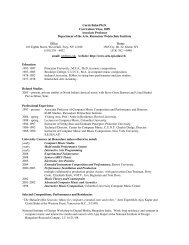
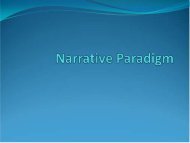
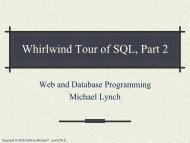
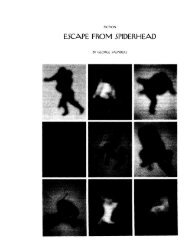
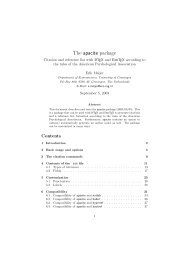
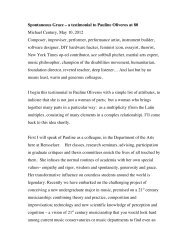

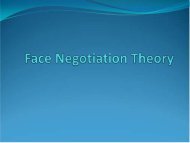


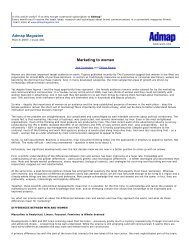

![The Game Design Document [.pdf]](https://img.yumpu.com/30117124/1/190x245/the-game-design-document-pdf.jpg?quality=85)
